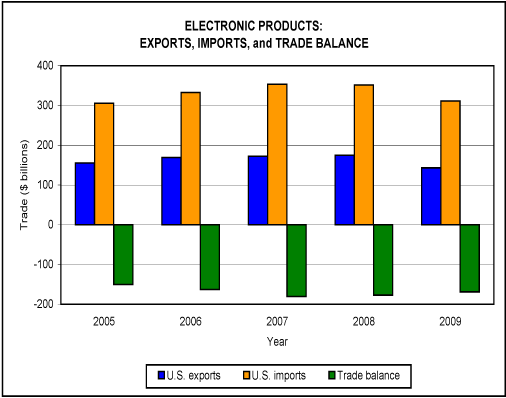View Section in Publication :: Return to Overview

Key Economic Trends
- The trade deficit for electronic products decreased by $8.3 billion as U.S. imports declined more than U.S. exports on an absolute basis. Imports dropped in every industry within the sector, due in large part to declines in demand brought about by the economic downturn, especially for items such as consumer audio and video equipment that are generally considered to be discretionary purchases.
- U.S. imports of electronic products decreased by $40.2 billion (11 percent) to $311.4 billion in 2009, as imports of computers, peripherals, and parts; telecommunications equipment; and consumer electronics accounted for 47 percent of the total decrease. U.S. imports of cellphones continued to rise despite the economic decline, as the increased unit values for cellphones with more advanced features made up for the lower volume of imports.
- U.S. exports of electronic products decreased by $31.9 billion (18 percent) to $143.0 billion in 2009. U.S. exports of semiconductors and integrated circuits; computers, peripherals, and parts; telecommunications equipment; and measuring, testing, and controlling equipment together accounted for 54 percent of total U.S. exports of electronic products and 76 percent of the decrease in exports in 2009.
- U.S. medical goods were the only product group for which exports increased significantly. The growth occurred primarily in exports of medical goods to China, which has been attempting to provide universal healthcare for its entire population.
Trade Shifts from 2008 to 2009
- U.S. trade deficit: Decreased by $8.3 billion (5 percent) to $168.5 billion
- U.S. exports: Decreased by $31.9 billion (18 percent) to $143.0 billion
- U.S. imports: Decreased by $40.2 billion (11 percent) to $311.4 billion
Selected Product Shifts
USITC Publications
- Wireless Handsets: Industry and Trade Summary, USITC Publication ITS-05, March 2010
- Multifunction Products: Industry and Trade Summary, USITC Publication ITS-03, December 2009
Other Government Resources
- U.S. Department of Commerce (USDOC), National Institute of Standards and Technology
- USDOC, International Trade Administration, Medical and Dental Equipment
- U.S. Food and Drug Administration, Center for Devices and Radiological Health
Other Resources
